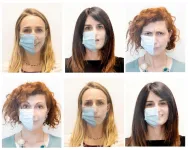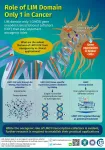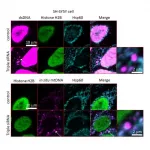Children cannot understand sadness and happiness in people wearing facemasks
The study published in Frontiers in Psychology shows that children aged from 3 to 5 years old are able to understand the emotions hidden under facemasks on just 40% of occasions.
2021-06-10
(Press-News.org) Genova (Italy) 10 June, 2021 - The U-Vip (Unit for Visually Impaired People) research team led by Monica Gori at the IIT- Istituto Italiano di Tecnologia (Italian Institute of Technology) has recently published a study which shows for the first time how children aged from 3 to 5 years old have problems in recognising the emotions of people wearing surgical masks. This collateral effect of the preventive measures linked to the Covid-19 health emergency could influence the correct development of children's capabilities of social interaction. The research paper has been published in Frontiers in Psychology.
The use of facemasks for children within the context of the COVID-19 pandemic was a focus of a document compiled by the World Health Organisation (WHO) and UNICEF to provide guidance for decision-makers and authorities in public and professional fields, discouraging exposure to the use of facemasks when dealing with children aged up to five years old. In addition, even for older children, WHO recommends giving careful consideration to the benefits of wearing facemasks in comparison with the potential damage that could include social and psychological problems, and difficulties in communication and learning.
The study by the IIT research team led by Monica Gori regards this context, and, for the first time it focuses on pre-school age group and it helps define the measures that can be taken to reduce the impact of the use of surgical masks amongst children. In fact, even though from 3 to 5 years of age, wearing facemasks is not mandatory, children are in any case exposed to the use of such preventive measures in various everyday social and educational contexts.
The IIT researchers prepared a quiz containing images of people with and without facemasks, and displayed them by computer, tablet or smartphone to 119 individuals comprising 31 children aged between 3 and 5 years old, 49 children between 6 and 8 years old, and 39 adults between 18 and 30 years old. The subjects, independently or with parental assistance in the case of the youngest participants, were asked to try to recognise the faces' expressions, with and without facemask, conveying different emotions such as happiness, sadness, fear and anger.
The results showed that children aged between 3 and 5 years old are capable of recognising facial expressions conveying happiness and sadness on only 40% of occasions when the faces are covered by a facemask. The percentages were higher for other age groups: children aged from 6 to 8 years old (55-65%) and adults (70-80%) but in general, all age groups showed a degree of difficulty in interpreting these emotions expressed while the face was partially covered by a facemask. As regards the other emotions, there were better results, but we can say that the age group that finds it hardest to recognise emotions expressed from behind a facemask is that of children in pre-school age.
"The experiment was performed in the earliest phases of the 2020 pandemic, and at that time facemasks were still a new experience for everyone.", comments Monica Gori, "Children's brains are highly flexible, and at the moment we are performing tests to ascertain whether children's understanding of emotions has increased or not", concludes Gori.
"In the study, we worked with children and adults with no forms of disability", explains Maria Bianca Amadeo, IIT researcher and co-author of the research study, "of course, these observations are even more important when considering children affected by disabilities". "Indeed", explains Lucia Schiatti, IIT researcher and co-author of the study "for example visual impairment implies difficulties in social interaction. For such individuals in particular, it will be even more necessary to concentrate on possible preventive measures or specific rehabilitation activities".
Over the next few years, it will be essential to perform work designed to explore the actual impact of this preventive health measure on children's ability to interact, both those affected by disabilities and those without disabilities.
In the meantime, the IIT study suggests considering the use of transparent facemasks for all operators in contact with children in the 3-5 year-old age group, or the formulation of specific training activities designed to teach children how to recognise emotions purely through observation of the eyes.
INFORMATION:
Additional information
Monica Gori
Monica Gori is tenure track researcher leading the Unit U-Vip: Unit for Visually Impaired People at the Istituto Italiano di Tecnologia. Monica Gori is an expert of development, multisensory integration, rehabilitation, cortical plasticity and visual disability. The impact of her work on the scientific community can be summarized by 130 international papers, 5 book chapters, and many conferences' abstracts. She was the scientific coordinator of two large European grants, ABBI (http://www.abbi.eu ) and WeDraw (http://www.wedraw.eu ). One of her works has been listed in faculty of 1000 (Gori et al. Curr Biol, 2008). In 2012, she won the TR35 price for young innovators. In 2021 Monica was awarded with an ERC STG grant for the MYSpace project (http://www.myspaceproject.eu).
Istituto Italiano di Tecnologia
Istituto Italiano di Tecnologia (IIT - Italian Institute of Technology,) is a scientific research center established by law in 2003 by Italian Ministry of Education, University and Research and Ministry of Economy and Finance, in order to promote excellence in both basic and applied research and to facilitate the economic development at national level. IIT scientific activities started in 2006, they are multidisciplinary and with a very strong approach to technology transfer. IIT staff is of 1700 people, the majority of which (about 81%) is dedicated to research, and an average age of 36 years. About half of the researchers come from abroad: 34% are scientists from more than 50 foreign countries and 16% are Italian researchers who have come back to Italy after a professional experience abroad. IIT has a vast experience in managing and supervising research projects with a portfolio of more than 450 external funded research projects, also financed by EU funding programs and European Research Council (ERC). IIT has produced more than 14500 publications and 294 inventions; its research activity led to the creation of 24 spin-offs, with additional 30 under due diligence. Research is carried out in the Central Research laboratory in Genoa (IIT headquarters), in 11 research satellite centers across Italy and in 2 outstations in US. IIT scientific vision is interdisciplinary, based on the concept of "translating evolution into technology", that is mimicking natural solutions to develop new technologies in the fields of robotics, materials science, and life science. Currently IIT is conducting its new scientific plan (2018-2023) developing four strategic research domains: Robotics, Nanomaterials, Technologies for Life Science, and Computational Sciences. The main goal is to produce technologies that will have a positive impact on some important societal challenges, such as sustainability and the environment, healthcare and aging society, also reflecting the priorities of EU framework programs.
[Attachments] See images for this press release:

ELSE PRESS RELEASES FROM THIS DATE:
2021-06-10
Actively restoring oyster reefs--beyond simply protecting them from harvest--can create big payoffs for habitat quality and the other species that flock to them. A new study from the Smithsonian Environmental Research Center (SERC), published June 3 in the journal Marine Ecology Progress Series, compared restored, protected and harvested areas using photos and video footage from roughly 200 sites.
Roughly a quarter of Maryland's oyster habitat lies protected in oyster sanctuaries. But only a small fraction of those sanctuaries have undergone full-scale restorations, with reconstructed reefs and new live oyster plantings. ...
2021-06-10
A new study reports that birds across the continental U.S. tend to avoid backyard feeders in louder areas. When light and noise pollution were both present, even more species stayed away.
The study, published in Global Change Biology, used data from the community science program Program FeederWatch. The research team analyzed more than 3.4 million observations of 140 different bird species across the continental U.S.
"Broadly speaking, we are just starting to dive into the consequences of light and noise for animals," said Ashley Wilson, a graduate student at California Polytechnic State University who led the study. "Most studies focus on a single species' responses to noise or light pollution. As such, our study involving 140 species provides the most comprehensive assessment ...
2021-06-10
Humans have been plagued by a myriad of deadly cancers since ages. Parallelly, they have also been attempting different permutations and combinations of treatments to cure the disease. Part of these attempts involving biomolecular targets have come to the fore in recent years. Like a broad-spectrum antibiotic that can attack and eliminate several microbes at a time, some of these biomolecular targets, when manipulated appropriately, can alleviate different cancers. One such biomolecular target of interest is LIM domain only 1 gene (LMO1).
LMO1 codes for a protein 'connector' that helps in the assembly ...
2021-06-10
Increasing evidence shows that physical activity and exercise training may delay or prevent the onset of Alzheimer's disease (AD). In aging humans, aerobic exercise training increases gray and white matter volume, enhances blood flow, and improves memory function. The ability to measure the effects of exercise on systemic biomarkers associated with risk for AD and relating them to key metabolomic alterations may further prevention, monitoring, and treatment efforts. However, systemic biomarkers that can measure exercise effects on brain function and that link to relevant metabolic responses are lacking.
To address this issue, Henriette van Praag, Ph.D., from Florida Atlantic University's ...
2021-06-10
Highly dispersed platinum catalysts provide new possibilities for industrial processes, such as the flameless combustion of methane, propane, or carbon monoxide, which has fewer emissions and is more resource efficient and consistent than conventional combustion. In the journal Angewandte Chemie, a team of researchers reports on which platinum species are active in high-temperature oxidations and what changes they can undergo in the course of the process--important prerequisites for the optimization of catalysts.
Individual metal atoms and clusters consisting of only a few metal atoms have interesting catalytic properties determined by the exact nature of the active metal species. Usually, these are highly dispersed and deposited on ...
2021-06-10
Black people have a higher risk of colorectal cancer than white people, but this risk is likely not due to genetics. Data from a recent study by researchers from the U.S. Department of Veterans Affairs, Regenstrief Institute and Indiana University School of Medicine adds more data to the existing evidence.
"The next step is determining what is behind this increased risk," said lead author Thomas Imperiale, M.D., Regenstrief Institute research scientist, VA investigator and professor of gastroenterology and hepatology at IU School of Medicine. "Lifestyle and healthcare-related behaviors may explain some of the difference." ...
2021-06-10
Washington, D.C. - June 9, 2021 - The Pfizer COVID-19 vaccine is protective against several SARS-CoV-2 variants that have emerged, according to new research presented in the journal mBio, an open-access journal of the American Society for Microbiology. While this is good news, the study also found that the only approved monoclonal antibody therapy for SARS-CoV-2 might be less effective against SARS-CoV-2 variants in laboratory experiments.
"The vaccines provide very strong protection against the earlier forms of the virus as well as the newer variants. This is an important point because I have heard people say that they don't think there is a reason to get vaccinated, because the vaccine isn't going to ...
2021-06-10
Scientists say naked mole rats - a rodent native to West Africa - may hold the key to new treatments for degenerative diseases such as cancer and dementia.
The reclusive animals have a lifespan far in excess of other rodents - for example, mice and rats live about two years, whereas naked mole rats can live for 40 or 50 years.
Researchers at the University of Bradford say the animals have a unique DNA repair mechanism that enables them to prevent cancers and other degenerative conditions, including dementia.
Cancer resistant
Professor Sherif El-Khamisy, Director of the Institute of Cancer Therapeutics at the University, said: "Naked mole rats are fascinating ...
2021-06-10
Niigata, Japan - Researchers from Brain Research Institute, Niigata University, Japan may have unraveled a new approach that could revolutionize the treatment, prevention, and possibly reversal of the damages that could lead to Parkinson's Disease (PD). This novel finding utilizing the cellular and zebrafish models, demonstrated how the leakage of mitochondrial dsDNA into the cytosol environment of the cell can contribute to the impairment of brain tissue of patients with PD.
Parkinson's disease is the second most common neurodegenerative disease, and its prevalence ...
2021-06-10
Surgeons can ease their patients' pain from common operations without prescribing opioids, and avoid the possibility of starting someone on a path to long-term use, a pair of new studies suggests.
Treating post-surgery pain with non-opioid pain medications such as ibuprofen or acetaminophen didn't lead to higher pain levels or more serious issues during recovery, and didn't dampen patients' satisfaction with their care, according to new results from a study of more than 22,000 patients who had one of seven common operations at 70 hospitals.
The team behind the study has also produced a free, evidence-based guide for surgeons and other acute care providers, ...
LAST 30 PRESS RELEASES:
[Press-News.org] Children cannot understand sadness and happiness in people wearing facemasks
The study published in Frontiers in Psychology shows that children aged from 3 to 5 years old are able to understand the emotions hidden under facemasks on just 40% of occasions.





